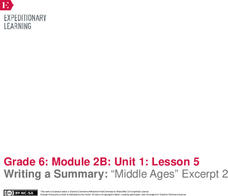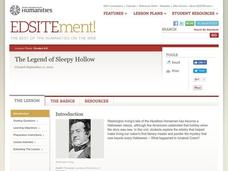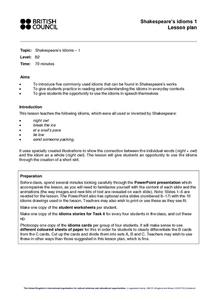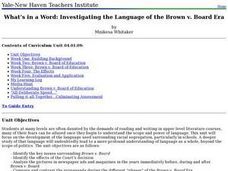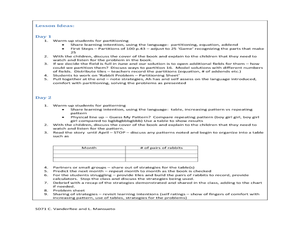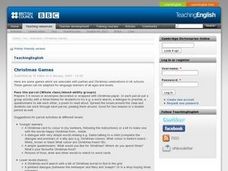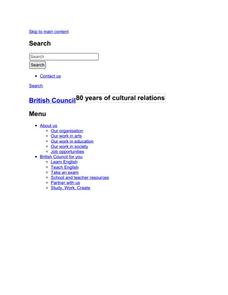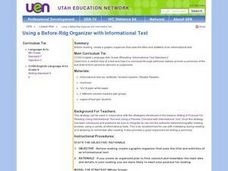EngageNY
Analyzing Main Ideas and Details: Why Care about Water?
Pay attention to details! After completing text-dependent questions about paragraphs 10-12 of "Water is Life," scholars view the video "Why Care about Water. "They view the video three times and use a Main Idea and Details note-catcher...
EngageNY
Writing a Summary: “Middle Ages” Excerpt 1
What's this all about? Scholars learn the importance of summarizing skills using a summary writing graphic organizer. They work with an elbow partner to discuss summaries and complete the organizer using Middle Ages Excerpt 1. Learners...
EngageNY
Writing a Summary: “Middle Ages” Excerpt 2
What is the big idea? Scholars use Middle Ages Excerpt 2 to complete a summary graphic organizer. They then use the information from the organizer to write a summary of the text on lined paper. Learners share summaries with the class.
Curated OER
Knowledge or Instinct? Jack London's "To Build a Fire"
Students examine the relationship of man and nature in "To Build a Fire" and discuss the juxtaposition of knowledge and instinct. They investigate third person, omniscient point of view.
Curated OER
Introducing Jane Eyre
"How can a magazine reflect a particular time and culture?" Using this prompt, your class explores the Victorian Era as it relates to Charlotte Bronte's Jane Eyre. They can also play the "Victorian Women's Rights" game for the year 1840...
Curated OER
The Stuff of Stories: Using Museums to Inspire Student Writing
Middle schoolers write descriptions, narratives, and dialogues based on objects of art and time periods in a museum. They base several writing assignments on art objects and paintings, including a literal description and an emotional...
Curated OER
Foreshadowing and Prediction: W.W. Jacob's, "The Monkey's Paw"
W.W. Jacobs' story "The Monkey's Paw" provides plenty of foreshadowing which readers use to make predictions in this tightly composed, sound instructional plan. Your class reads the story, recording predictions and checking for veracity...
Curated OER
The Legend of Sleepy Hollow
Explore Washington Irving's "The Legend of Sleepy Hollow" in this literature analysis lesson. Middle schoolers read and summarize the plot of the story. They then adapt passages for a contemporary audience and analyze the...
Curated OER
Marketing to Teens: Parody Ads
High schoolers deconstruct advertising messages by analyzing parody ads and exploring the purpose of satire. Then they create their own parodies based on real ads discussed in class. A creative activity to extend any study of media,...
Curated OER
Who's In, Who's Out?
Working in groups, class members develop survey questions to be used on campus to identify groups that feel excluded or disrespected. After assembling the questions and conducting the survey, class members analyze their findings and...
Poets.org
Love as a Two-way Street
Create an abundance of understanding, as your high school learners learn to analyze multiple love poems. Part one of this resource has learners define what love is, examine art that reflects the love between Robert and Elizabeth...
UAF Geophysical Institute
System Interactions: The Lorax and the Truffula Tree
If the Lorax were to write a letter, what would he write? Introduce your class to systems and feedback loops through the whimsical stylings of Dr. Seuss. Learners take on the Lorax's point of view to write a letter, among other activities.
British Council
Shakespeare’s Idioms
Lie low. Break the ice. He's a night owl. Idioms, in this case idioms created by Shakespeare, are the focus of resource that includes a PowerPoint presentation, an activity, and a brief lesson, all intended to give kids a chance to...
Star Wars in the Classroom
"Shakespeare and Star Wars": Lesson Plan Days 13 and 14
How important are sound effects in films? In stage plays? In radio programs? To gain an understanding of the impact of these special effects, class members watch a short video spoof of the sound in a scene from Star...
Curated OER
What's in a Word: Investigating the Language of the Brown v. Board Era
Students focus on the development of the language used surrounding racial segregation, particularly in schools. They identify the key issues surrounding Brown v. Board and identify the effects of the Court's decision. They analyze the...
Curated OER
The Rabbit Problem
Students notice a number pattern in the book The Rabbit Problem by Emily Gravett. In this number pattern lesson, students represent and describe numbers appropriate to their grade level.
Curated OER
Spiro Mounds; Oklahoma's Past Indian History
Young scholars create an understanding of Oklahoma's past.
Curated OER
Christmas Games
Your class will practice language and dialog skills by playing games associated with Christmas through these lesson ideas. Learners practice English conversation skills while simultaneously acquiring insight into their new culture. Games...
Curated OER
Card Game to Encourage Discussion
How do you get your class talking? Use a card like the one included to help English language learners join the discussion. On this card, for example, nine sentence starters are provided. You could also use this with native English...
Curated OER
Introducing Communication Talent with "Casey at the Bat"
Analyze the poem "Casey at the Bat." Your team of analysts will read the poem and complete a variety of activities, including describing how Casey looks and acts, describing how he feels before and after he strikes out, and sharing...
Curated OER
Language Arts: Before-Reading Organizers
Sixth graders discover how to create graphic organizers using the titles and subtitles of informational texts. Following a teacher demonstration, they work in pairs to create their own organizers based on assigned texts. Upon...
Curated OER
Language Arts: Women in History
Learners read excerpts from Amelia Earhart's autobiography, "The Fun if It," and identify her character traits. To aid visualization of her transatlantic flight, they search books and the Internet for photos related to Earhart's flights....
Curated OER
Oral Language in Mathematics
Third graders examine fractions by descriptively writing about them. For this number sense lesson, 3rd graders read number sentences and compare fractions based on their size. Students explain fractions to a friend by writing a friendly...
Curated OER
Self-esteem Activity
Students create lists of positive and negative feelings and have discussions on the power of positive thinking. In this feelings lesson plan, students dissect situations where others are being negative.
Other popular searches
- Whole Language Lesson Plans
- Whole Language Approach
- Whole Language Development
- Reading Whole Language
- Whole Language Method
- Whole Language Instruction
- Whole Language Shared Reading
- Language Arts Whole Class
- Esl Whole Language Method
- \"Whole Language Approach\


